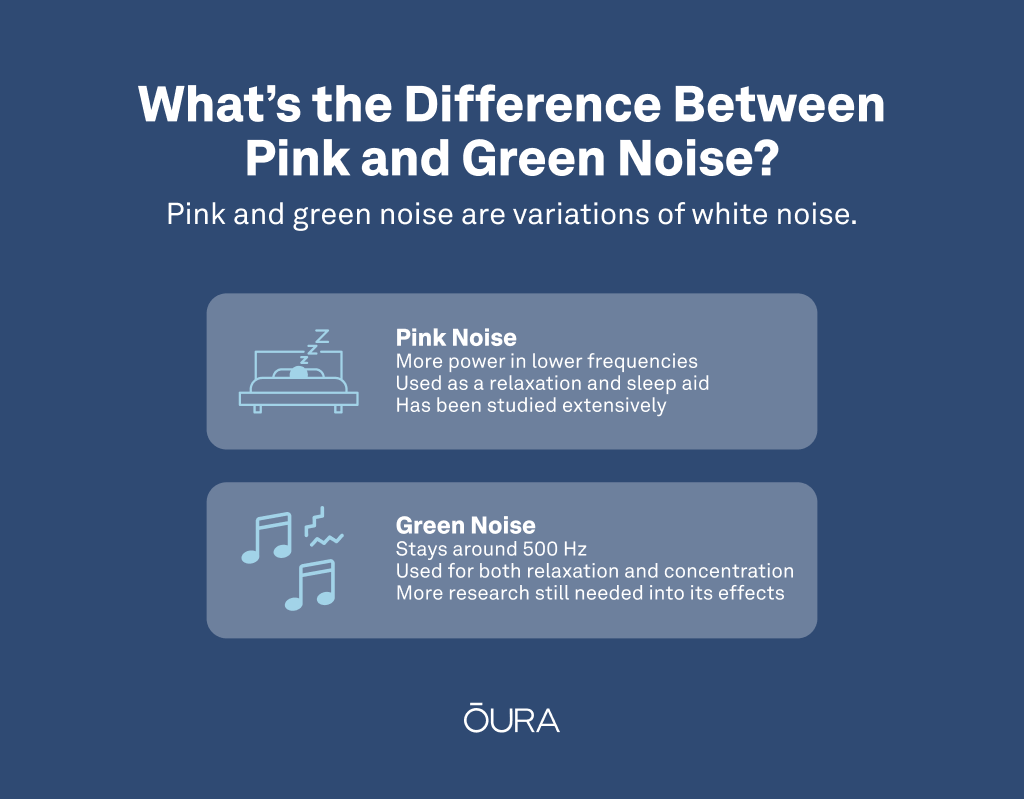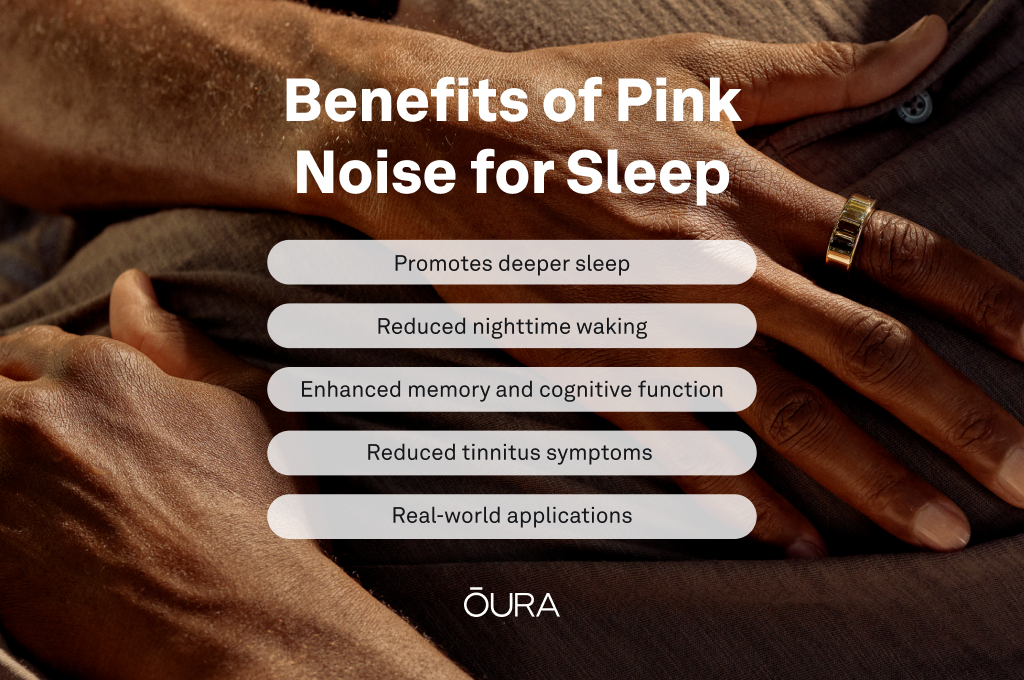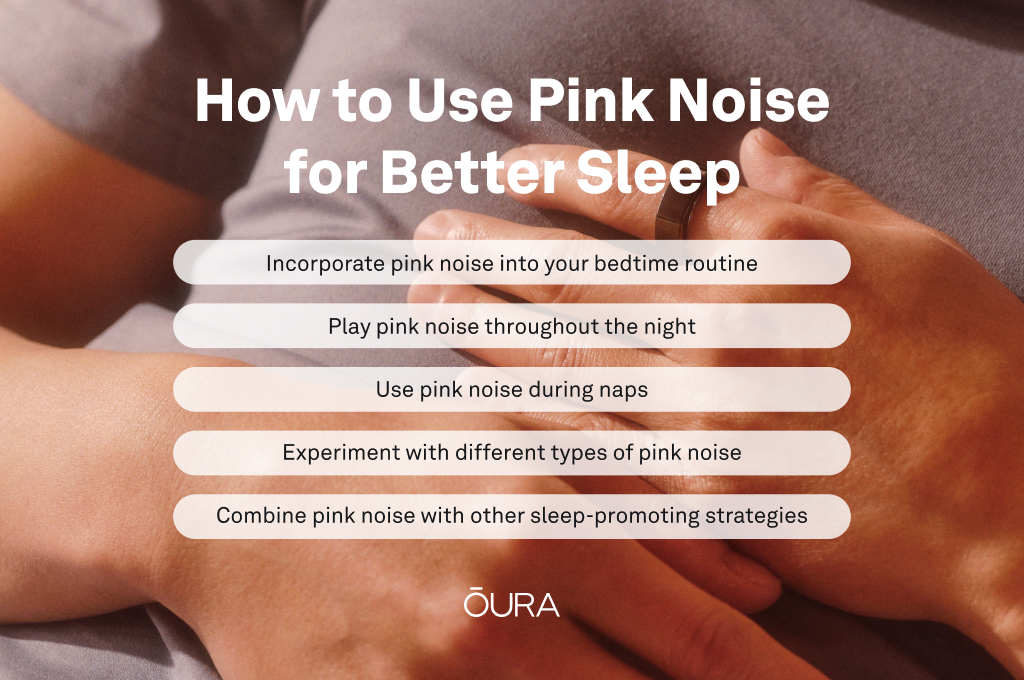If you’re looking for soothing sounds to help you sleep, you may have come across “pink noise” trending on social media platforms like TikTok.
Pink noise is a type of sound that has a steady, soothing quality that can help people fall and stay asleep throughout the night when used to produce ambient noise.
Pink noise is created by boosting low-frequency sounds, such as those found in nature, while reducing the volume of high-frequency sounds. This produces a lower pitch than white noise, which many people find more relaxing.
The effects of pink noise on sleep are well documented. For example, a 2017 study by a team of researchers at Northwestern University found that pink noise can help improve the quality of deep sleep and memory consolidation in older adults. The study involved playing pink noise during the night for the participants and measuring their brain activity during sleep.
The results suggest that different colors of noise may help you get a better night’s sleep when used as sleep sounds — while some people swear by pink noise, others prefer brown or red noise.
For now, let’s take a deep dive into what pink noise is, its benefits, and how you can incorporate background noise into your sleep habits. Read to the end for a free pink noise audio track that you can use to make every night a good night.
Oura members can receive instant feedback and biometric data, such as their heart rate, that shows their body’s response to the effects of pink noise. If you notice that listening to pink noise makes your heart rate drop, you’ll know that it activates your relaxation response and may help you get better sleep.
What Is Pink Noise?
To understand what pink noise is, let’s first look at what white noise is. White noise contains all frequencies at equal intensity to produce a steady sound — like TV static, a fan, or an air conditioner.
Pink noise is similar to white noise but is skewed toward the lower frequencies, with the amplitude (loudness) decreasing at a rate of three decibels per octave. This means you hear less of the higher frequencies and more power in the lower frequencies, creating a deep sound, like steady rain or wind on a beach.
Because of their lower tone, pink noise sounds tend to be more soothing than white noise and often consist of nature sounds like rustling leaves, a gentle stream, or ocean waves. You can find these sounds on sound machines, smartphone apps, and other sources of pink noise — including the audio below.
What’s the Difference Between Pink and Green Noise?
Both pink and green noise are variations of white noise with more power in the lower frequencies. Green noise stays around the middle of the spectrum, whereas pink noise produces a slightly lower sound.
RELATED: What Is Green Noise and Can It Help You Sleep Better?
While both types of noise can be created by recording nature sounds, there are differences and similarities in how they sound and the effect they may have on sleep quality. Let’s take a look at them.
Differences
- Frequency spectrum: With pink noise, the power decreases at a rate of three decibels per octave, giving it more power in the lower frequencies and producing a deep, steady sound. Green noise, on the other hand, has a higher concentration of mid-range frequencies of around 500 Hz.
- Effects on the body: Pink noise is often used as a relaxation and sleep aid because it has been found to help synchronize brain waves, leading to improved sleep quality. While green noise can also be used for relaxation and sleep, some people find it promotes focus and concentration, and prefer to use it for work or studying.
- Popularity: Pink noise is a well-established concept in the scientific community and has been used in a variety of research studies on sleep and brain function. Green noise, on the other hand, is a newer term that is less commonly used and has not been studied as extensively as pink noise.
Similarities
Both pink and green noise are colors of noise, which means they have a frequency spectrum that differs from white noise.

What Are the Benefits of Pink Noise for Sleep?
Pink noise has been found to help improve the quality of sleep by promoting deeper, more restorative sleep. Here’s how.
Promoting Deeper Sleep
Pink noise has been found to help promote deeper, more restorative sleep by slowing down and regulating brain waves. The 2017 study by Northwestern University found that exposure to pink noise during sleep led to an increase in slow wave sleep (SWS), which is the stage of sleep associated with physical restoration and memory consolidation.
Oura members can check their Sleep Score the morning after listening to pink noise to see if it has improved.
Reduced Nighttime Waking
Pink noise has also been found to help reduce nighttime waking and improve ‘sleep stability’, defined as the degree to which your nightly sleep goes uninterrupted. A 2023 study found that participants who listened to pink noise spent more time in deep sleep than those who did not listen to pink noise.
The Oura sleep staging algorithm shows members how much time they spend in each phase of sleep, including wakefulness.
RELATED: What Are the 4 Stages of Sleep?
Enhanced Memory and Cognitive Function
Pink noise has also been found to enhance memory consolidation during sleep. A study conducted in 2017 found that exposure to pink noise during sleep improved memory recall in older adults.
Oura members can consult their Readiness Score to determine whether their cognitive abilities are ready for action.
Reduced Tinnitus Symptoms
Pink noise has been found to help decrease symptoms of tinnitus, a condition that causes the sufferer to experience a constant ringing or buzzing in the ears. A study conducted in 2017 found that patients with tinnitus who listened to white, red, or pink noise experienced a reduction in their symptoms.
Real-World Applications
Pink noise is commonly used in real-world settings, such as in hospitals, where it has been found to help improve sleep quality for patients. A study conducted in 2020 found that patients in an intensive care unit who were exposed to pink noise had improved sleep quality and reported feeling more rested and refreshed.

How to Use Pink Noise for Better Sleep
With all that science backing up the effectiveness of pink noise for sleep, it’s no wonder it’s become such a popular way to improve sleep quality.
If you’re ready to try pink noise, here are some ways to incorporate it into your sleep hygiene routine.
READ MORE: 5 Ways to Upgrade Your Sleep Hygiene
Incorporate Pink Noise into Your Bedtime Routine
One of the best ways to use pink noise for sleep is to incorporate it into your bedtime routine. You can do this by playing it through a pink noise machine or a phone app that generates pink noise. Set the volume to a comfortable level and allow the pink noise to play in the background as you fall asleep.
Play Pink Noise Throughout the Night
If you have trouble staying asleep throughout the night, playing pink noise continuously can help promote deeper sleep and reduce nighttime waking. As we have seen, numerous studies show that exposure to pink noise during sleep can increase the amount of deep sleep and decrease wakefulness.
Use Pink Noise During Naps
If you need an energetic pick-me-up during the day, consider listening to pink noise during naps to promote restful and restorative sleep. In a 2013 study published in Neuron, researchers synced pink noise with participants’ brainwaves, so that it played when their brain activity registered deep sleep. Compared with no noise, the pink noise corresponded with a longer duration of deep sleep.
Experiment with Different Types of Pink Noise
There are various types of pink noise available, ranging from low-pitched rumbling sounds like distant thunder to higher-pitched sounds resembling rainfall or ocean waves. Experimenting with different types of pink noise can help you find the one that works best for you and your sleep needs.
RELATED: Got a Theory? Test It Out
Combine Pink Noise with Other Sleep-Promoting Strategies
Pink noise can be combined with other sleep-promoting strategies, such as meditation, deep breathing, and progressive muscle relaxation, to enhance the relaxing and sleep-promoting effects.
Oura members can access a library of over 70 guided meditations that help promote relaxation and deeper sleep.
RELATED: Try Oura’s Guided Meditations for Deep and Restful Sleep

Pink Noise: Free Audio
To help you get started on your pink noise journey, listen to this free pink noise to help you relax, unwind, and get a good night’s sleep.
READ MORE: Restless Sleep? How to Reduce Tossing and Turning at Night










